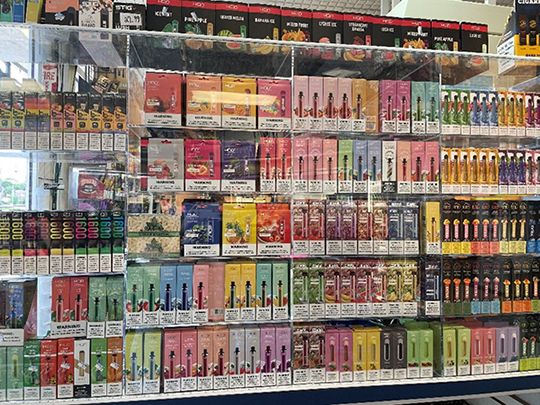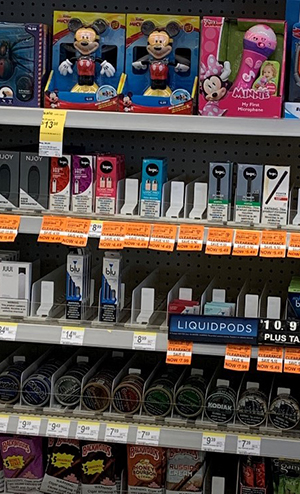News and Events
The Impact of Point-of-Sale Tobacco Advertising
March 14, 2022
You have probably seen countless retail locations that look like the one pictured in this article. You can probably name several local places that are littered with tobacco advertisements throughout the outside, on the windows, on gas pumps, or indoors. Tobacco advertisements at retail locations have become commonplace, and that is a problem. The tobacco industry spends 9.5 billion dollars a year marketing its products, with a majority of that budget allocated at the point of sale. In Florida alone, the tobacco industry spends 600 million dollars (1). With this money, the tobacco industry can control every aspect of the advertisements that you see at the store, from the location, types of ads, and even pricing (2).

| These industry tactics have a purpose; to attract youth users to their products. Youth who are exposed to advertisements at the retail point of sale at least twice are week are twice as likely to start using tobacco products (3). One of the products that have grown in popularity among youth has been electronic cigarettes. Currently, one in five high schoolers reports using an electronic cigarette device (4). The significant reason for the popularity of these devices is the use of kid-friendly flavors and packaging. Flavors are often listed as one of the top three reasons for youth trying these products (5). These tactics, coupled with advertisements close to schools and high retailer density, contribute to an increased risk that youth will start using tobacco products. |  |
The Tobacco Free Partnership of Indian River County is continuing to work towards bringing awareness to the industry's tactics to attract youth to their deadly products. Our Partnership is actively working to educate community members and retailers on the importance of keeping these products out of the hands of our youth. If you would like more information on our program or responsible tobacco retailing, please reach out to Kyleigh Savoie at ksavoie@quitdoc.com.
_________________________________________________________________
Reference:
- U.S. Federal Trade Commission (FTC), Cigarette Report for 2017, 2019, https://www.ftc.gov/system/files/documents/reports/federal-tradecommission-cigarette-report-2017-federal-trade-commission-smokeless-tobacco-report/ftc_cigarette_report_2017.pdf [data for top 5 manufacturers only].; FTC, Smokeless Tobacco Report for 2017, 2019, https://www.ftc.gov/system/files/documents/reports/federal-tradecommission-cigarette-repo.
- Feighery, E, et al., "Cigarette advertising and promotional strategies in retail outlets: results of a statewide survey in California," Tobacco Control 10:184-188, 2001.
- Henriksen, L, et al., "A longitudinal study of exposure to retail cigarette advertising and smoking initiation," Pediatrics126:232-238, 2010. http://pediatrics.aappublications.org/content/pediatrics/126/2/232.full.pdf?download=true. [accessed 2019 Aug 27].
- Florida Youth Tobacco Survey (FYTS), Florida Department of Health, Bureau of Epidemiology, 2019.
- Tsai J, Walton K, Coleman BN, et al. Reasons for Electronic Cigarette Use Among Middle and High School Students — National Youth Tobacco Survey, United States, 2016. MMWR Morb Mortal Wkly Rep 2018;67:196–200. 3.
- Myers AE, Hall MG, Isgett LF, Ribisl KM. "A comparison of three policy approaches for tobacco retailer reduction. https://www.ncbi.nlm.nih.gov/pubmed/25689540.




